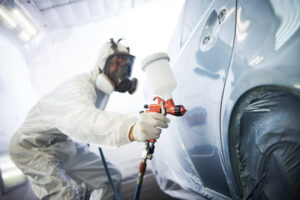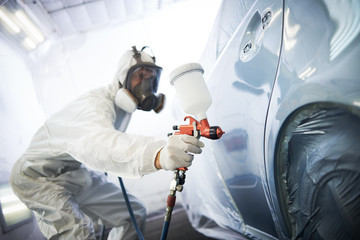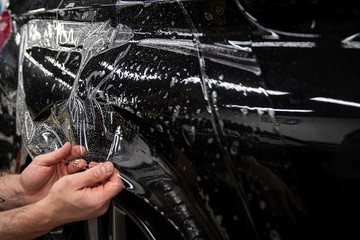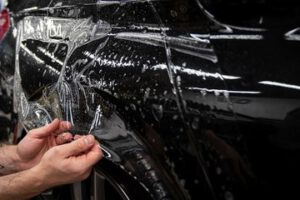Auto body painting is a complex task that requires professional equipment. A skilled automotive painter is capable of correcting mistakes, mixing paint, and following strict safety protocols.
Before a car can be painted, it needs to be sanded down. This can be done down to bare metal or just enough to give the paint a smooth even surface to bond to. Call Juanito’s Auto Body for an excellent service.
 Primer
Primer
The first step in auto-body painting is to apply primer. It will protect the surface of the car from rust and dirt. It will also provide a smooth surface for the paint job.
Before applying primer you should wash the surface of the car with soap and water. Any dirt, dust, or grit that is left on the surface will interfere with the adhesion of the primer and paint. You should also clean the surface of the car with a grease remover and wax remover.
Once you have prepped the surface of your car, and cleaned it with a degreaser, you will need to sand it down with 600-grit sandpaper. If you have done a lot of bodywork, then it will be necessary to resand the area before priming.
After sanding, you should again wash the surface of your car with soap and water. Then you should dry the surface. You should then apply a coat of etching primer to the surface of your vehicle. You will need to wait for the etching primer to dry before you can continue with your work.
Once the etching primer has dried, you can apply a normal primer. You should always read the instructions on the primer to find out how long you need to wait for the primer to dry before applying another coat. It is important to have a good-quality primer and to follow the directions on the can.
Some body shops use a special type of oil-based primer sealer to protect the car while it is in storage for a long period. This will prevent rust and other contaminants from eating away at the bare metal while the car is stored for a long period.
You should always use a primer-sealer that is compatible with the paint that you will be using on the project. If you mix different types of paints, then you will end up with compatibility problems that can cause issues like checking, crazing, and other surface defects. If you are unsure what type of primer to use, then you should consult with an automotive paint specialist.
Base Coat
A base coat is the first layer of paint that goes on a car before the top or final coating. It provides color to the finished product and enhances the appearance of a topcoat. It also acts as a sealer to prevent rust or corrosion. Many painters follow a specific formula for their base coat or buy it pre-mixed, but with practice and record keeping even newcomers can mix their base coat paint for projects.
Before applying the base coat, it is a good idea to use an automotive masking kit to cover parts of the vehicle that don’t need to be painted. This can be difficult and time-consuming, but it is the only way to guarantee that the paint job will turn out perfectly.
The next step is to abrade the surface of the vehicle using 400-600 grit sandpaper on a block or DA sander to prepare it for painting. The texture created by sanding will help the new coatings adhere to the vehicle. It is important to make sure that the sanded area is clean and dry. If there is any grease or wax on the surface, a commercial grease and wax remover should be used to clean it.
After sanding and cleaning, the vehicle can be spray-painted with the base coat. It is important to let the paint dry according to the manufacturer’s instructions. Once the base coat is dried, it can be wet sanded, and buffed to reveal the beautiful finish underneath.
Some paint manufacturers require a clear coat to protect the paint underneath. This protects the paint from the sun and keeps it shiny. The clear coat is also a great way to cover small scratches or dents that are not noticeable after the paint has cured.
If a new car is being built, the paint process begins with a primer, followed by a base coat, and then a clear coat. This ensures that the body will stay protected and look great for years to come. Whether your project is a car, boat, or motorcycle, preparation is key to getting the best results. Proper prep work can save you a lot of time and money in the long run.
Clear Coat
A clear coat provides the final layer of protection for your car’s paint job. It adds to the aesthetics of the car by giving it a glossy shine and also helps it hold up against scratches and other environmental contaminants.
A quality clear coat can reduce the appearance of minor scratches and can also help protect the car’s paint color from fade caused by UV rays. A clear coat can also improve the longevity of a paint job by protecting it from harmful chemicals in cleaning products, airborne pollution, bird droppings, and road salt.
When applying a clear coat, it’s important to use the proper materials and spraying technique. It’s a good idea to test the clear coat on a scrap piece of metal before you apply it to your car. This will allow you to practice the application process, and make any necessary adjustments before working on your actual vehicle.
In addition, it’s a good idea to wax your car regularly, as this will help keep the clear coat protected and looking great. Waxing will also help to remove dirt and other contaminants from the surface of your car, making it easier for you to clean when the time comes to wash it again.
It’s also important to avoid using abrasive rubbing compounds or polishing agents on your car, as this can damage the clear coat. In some cases, a clear coat may become oxidized, which can leave certain areas of the car unprotected and susceptible to rust. If this happens, it’s important to consult a professional to restore the clear coat and prevent further damage.
In general, a clear coat can last for a long time with normal care and maintenance. You don’t have to worry about it requiring special cleaning procedures or delicate handling compared to single-stage paint jobs. However, it’s still a good idea to clean your car regularly to remove contaminants, such as harmful chemicals and airborne pollutants that can eat away at the clear coat and cause corrosion on other parts of the car. You should also use a high-quality wax or sealant to help extend the life of your clear coat and to keep it looking glossy.
Finish
The clear coat is the final step in a paint job and protects the base or color coat. It’s also the coat that comes into direct contact with your vehicle’s surroundings, so it needs to be durable and able to resist harmful UV rays.
When interviewers ask about your experience with different automotive plastics and substrates, they’re looking for evidence of your knowledge and adaptability. The type of materials you use can affect the quality of your work and how easy it is for you to meet customer expectations, so knowing how to apply a variety of products demonstrates that you’re equipped to tackle a wide range of projects.
What Is The Best Way To Prepare A Surface For Painting?
Achieving a perfect finish requires meticulous attention to detail. Interviewers want to ensure that you understand the steps involved in cleaning, sanding, and priming the surface to be painted. This shows that you have the skills needed to deliver a high-quality, professional result and meet the standards of your employer.
Whether you’re using liquid or powdered paint, it’s important to take steps to minimize overspray and waste during the painting process. This not only saves you time but also helps to reduce costs and improve environmental responsibility. Interviewers are likely to ask about your methods for minimizing overspray and waste so they can gauge your commitment to efficiency, cost-effectiveness, and quality.
In addition to these technical aspects of auto body painting, interviewers may also want to hear about your ability to manage unique or challenging projects. They’re interested in hearing about your ability to adapt and overcome obstacles to provide exceptional results for your clients.
While some auto body painters are skilled at applying basic finishes like glossy or matte, other professionals are embracing new trends and developing their techniques. For example, some car brands are now offering a pearlescent paint finish on their latest models that gives the vehicles a sleek, metallic look. Others are experimenting with ceramic crystals to give their cars a more matte appearance, similar to vintage automobiles.


 Installing Paint Protection Film will save you money in the long run compared to regular repainting. It can help keep your car looking newer for longer. Also, it will prevent you from repainting your car often. Plus, it doesn’t require any trimming! You can choose from a library of pre-cut PPF templates or use your own.
Installing Paint Protection Film will save you money in the long run compared to regular repainting. It can help keep your car looking newer for longer. Also, it will prevent you from repainting your car often. Plus, it doesn’t require any trimming! You can choose from a library of pre-cut PPF templates or use your own.